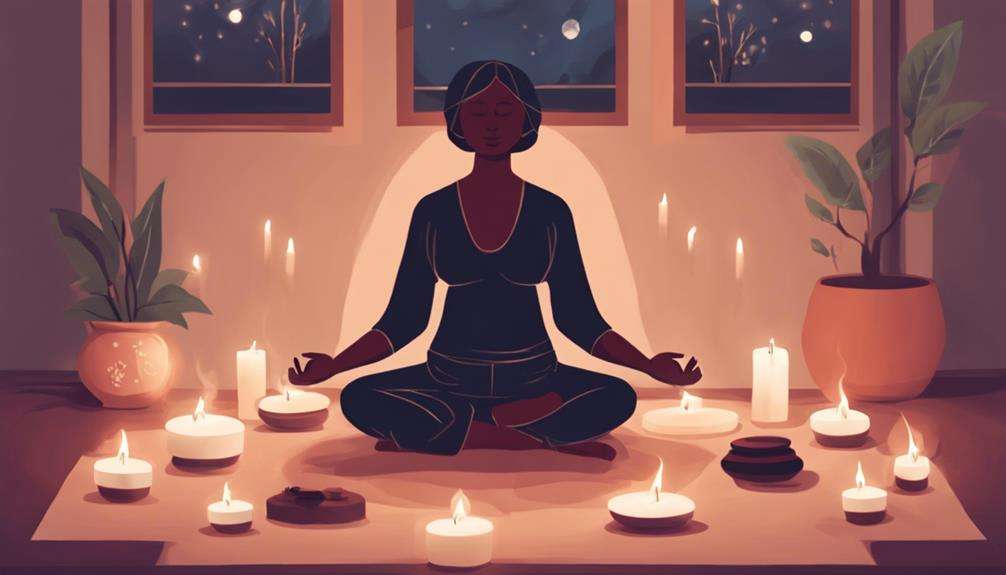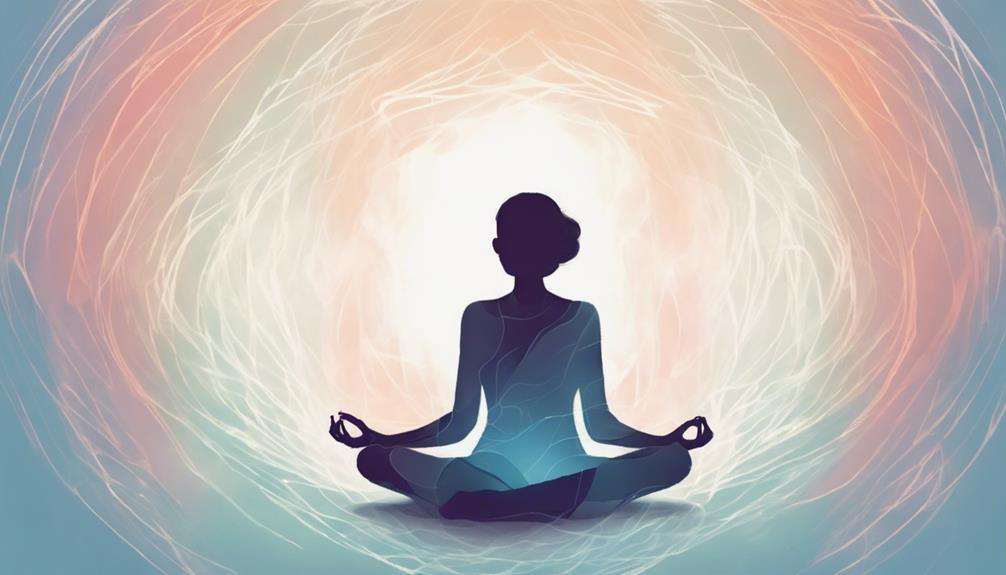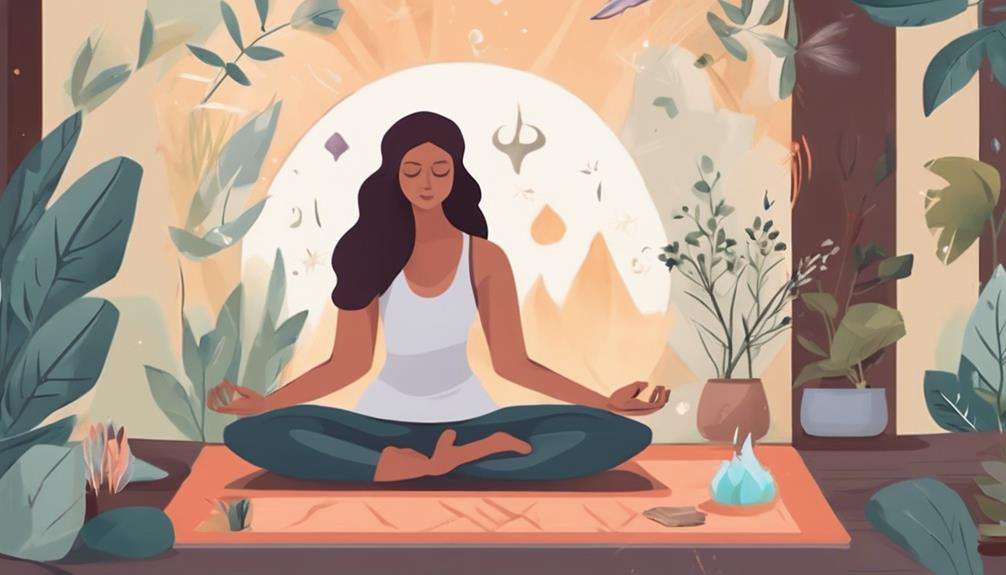You may think that managing anxiety through mindfulness practices sounds challenging or time-consuming, but incorporating these techniques into your daily routine can make a significant difference in how you approach and cope with anxiety.
Discover how simple practices like mindful breathing, body scan meditations, and cultivating self-compassion can help you navigate anxious thoughts and emotions more effectively.
These techniques offer practical ways to alleviate anxiety and promote a sense of calm and well-being, empowering you to take control of your mental state and lead a more balanced life.
Key Takeaways
- Deep breathing activates calmness and reduces anxiety symptoms effectively.
- Grounding techniques detach from overwhelming feelings and promote stability.
- Meditation practices cultivate self-awareness, calmness, and emotional well-being.
- Mindful movement like yoga and Tai Chi enhances relaxation and manages anxiety triggers.
Mindful Breathing Techniques
To ease your anxiety and find moments of peace, practicing mindful breathing techniques can help you regain control over your mind and body. When you engage in deep breathing, you activate the parasympathetic nervous system, which in turn reduces symptoms of anxiety such as a rapid heartbeat and shallow breathing.
Square breathing, a simple yet effective technique, involves inhaling for a count of 4, holding for 4, exhaling for 4, and holding for 4, promoting relaxation and bringing calmness during anxious moments. Additionally, diaphragmatic breathing, also known as belly breathing, helps release tension and fosters a sense of tranquility when anxiety arises.
Mindful breathing serves as a convenient tool for managing anxiety since it can be done anytime and anywhere. By incorporating these techniques into your daily routine, you can effectively calm your mind, reduce anxiety symptoms, and navigate through stressful situations with greater ease.
Grounding Practices for Anxiety Relief
Grounding practices play a crucial role in providing relief from anxiety by helping individuals stay present and centered during moments of distress. When anxiety strikes, grounding techniques such as square breathing and breath awareness can assist in detaching from overwhelming feelings and focusing on the present moment.
These practices enable individuals to break free from automatic reactions triggered by anxiety-inducing situations, consequently reducing emotional responses to various triggers. By incorporating grounding exercises into daily routines, individuals can cultivate a sense of calm and stability amidst the chaos that anxiety brings.
These mindfulness techniques empower individuals to shift their focus away from anxious thoughts and sensations, promoting a more grounded and centered state of being. Embracing grounding practices offers a pathway to navigate anxiety with resilience and composure, fostering a deeper connection to the present moment and a greater sense of inner peace.
Body Scan Meditation for Calming Anxiety
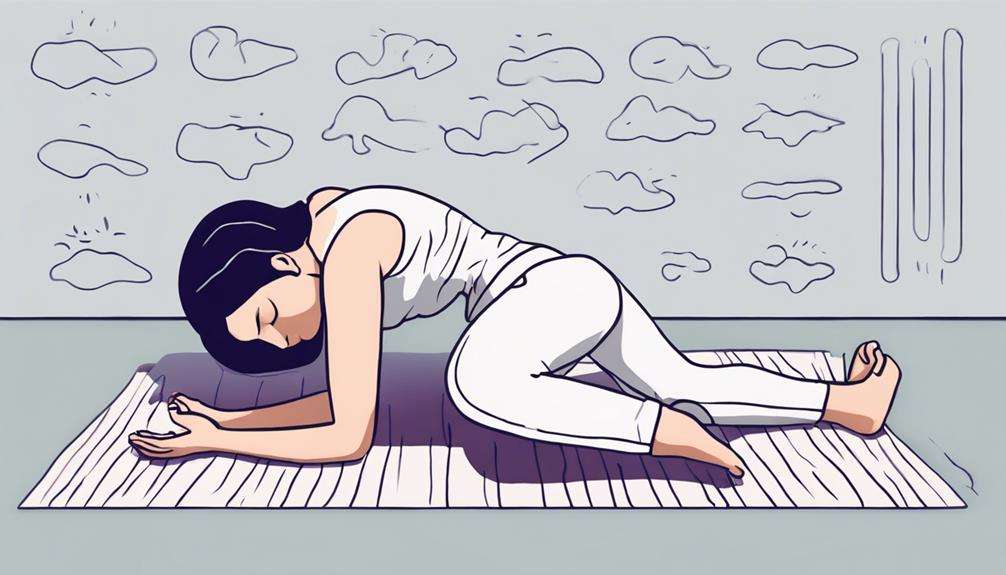
When feeling overwhelmed by anxiety, engaging in body scan meditation can be a valuable tool for calming your mind and body.
By systematically focusing on different body parts, you can increase your awareness of tension, release stress, and cultivate a sense of calm.
This practice not only promotes relaxation but also enhances your emotional well-being through improved mind-body connection.
Benefits of Body Scan
Engaging in body scan meditation regularly can significantly alleviate anxiety by promoting relaxation and increasing body awareness. Body scan meditation, a mindfulness practice, focuses on tuning into physical sensations to reduce tension and promote calm.
Research has shown that this technique is effective in decreasing symptoms of anxiety, stress, and depression. By incorporating body scan meditation into your daily routine, you can enhance your body awareness and develop a deeper connection with how your body responds to stressors.
This heightened awareness allows you to address areas of tension and discomfort, leading to a more relaxed state of being. Through the practice of body scan meditation, you can cultivate a sense of tranquility and effectively manage anxiety.
How to Practice
To practice body scan meditation for calming anxiety effectively, start by finding a comfortable and quiet space where you can fully focus on your body and breath. Begin by bringing your attention to your feet, slowly moving upward through each part of your body, noticing any sensations without judgment. This mindfulness practice helps reduce stress, promote relaxation, and enhance body awareness.
Mindfulness Meditation for Inner Peace
Mindfully embracing the present moment through meditation can lead you to a profound sense of inner peace and tranquility. By engaging in mindfulness meditation, you can effectively reduce symptoms of anxiety and promote a state of calmness. Research suggests that this practice not only lowers stress levels but also enhances overall mental well-being. Techniques like body scan and breath awareness are powerful tools within mindfulness meditation that help in alleviating anxiety and inducing relaxation.
During mindfulness meditation for inner peace, the focus lies on observing thoughts without judgment and fostering self-compassion. This approach allows you to acknowledge your thoughts and feelings without getting entangled in them, promoting a sense of inner harmony. By cultivating self-compassion through mindfulness, you can create a space for acceptance and kindness towards yourself, further enhancing the feeling of tranquility within. Embracing mindfulness meditation as a daily practice can significantly contribute to your mental and emotional well-being, leading you towards a more peaceful state of mind.
Cultivating Self-Compassion Through Mindfulness

When practicing mindfulness for anxiety relief, it's essential to understand the importance of cultivating self-compassion.
Being kind to yourself, embracing imperfections, and practicing mindful self-validation are crucial aspects of this process.
Kindness Toward Self
Practicing kindness toward yourself through mindfulness involves nurturing a compassionate attitude towards your own struggles and anxieties.
- Embrace self-compassion: Treat yourself with the same kindness you'd offer a friend facing anxiety.
- Foster self-acceptance: Acknowledge your imperfections without harsh self-judgment, promoting emotional well-being.
- Cultivate inner dialogue: Develop a supportive self-talk that encourages self-care and understanding during anxious moments.
Embracing Imperfections
To cultivate self-compassion through mindfulness and embrace imperfections, it's essential to acknowledge your flaws and struggles without resorting to self-judgment or criticism. By accepting your imperfections with kindness and understanding, you're fostering self-compassion, which in turn can reduce anxiety and enhance emotional resilience.
Mindfulness encourages you to develop a positive relationship with yourself, recognizing that imperfections are a natural part of being human. Embracing imperfections without harsh judgment leads to greater self-acceptance and a more compassionate outlook towards yourself. This shift in mindset can help ease anxiety symptoms and promote a sense of inner peace.
Mindful Self-Validation
Embracing mindfulness in self-validation fosters a compassionate understanding of your emotions without judgment or criticism. When practicing mindful self-validation, you cultivate self-compassion, promoting emotional well-being and inner peace.
By treating yourself with kindness and acceptance, you build resilience against anxiety, fostering a more positive relationship with your thoughts and feelings. Research indicates that incorporating mindfulness practices focused on self-compassion can lead to significant anxiety relief and improved overall emotional health.
Noting and Letting Go of Anxious Thoughts
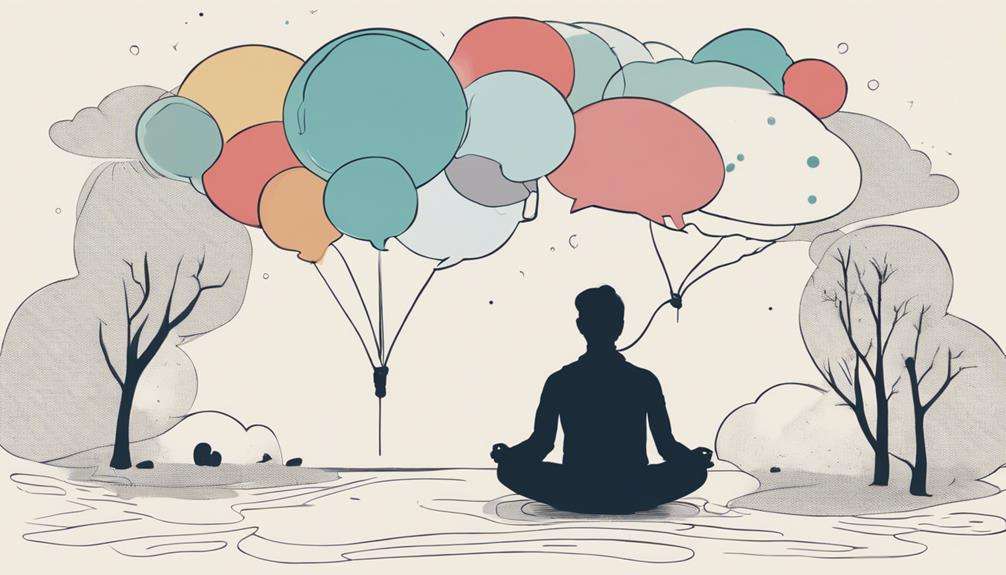
When anxious thoughts arise, noting them without becoming entangled can foster mindfulness and reduce reactivity. Noting allows you to observe these thoughts without judgment, creating space between you and the anxiety-provoking ideas. By acknowledging and noting these anxious thoughts, you can let go of them more easily, preventing them from spiraling out of control. This practice helps in promoting non-reactivity, leading to mental clarity and emotional well-being.
Letting go of anxious thoughts through noting enables you to develop a healthier relationship with your mind. Instead of getting caught up in the worries and fears, you can observe them from a distance. Research indicates that this practice can result in decreased levels of anxiety and overall improved mental health outcomes. By incorporating noting and letting go into your mindfulness routine, you empower yourself to navigate challenging moments with a greater sense of calm and resilience.
Mindful Movement Practices for Anxiety Management
Engage in mindful movement practices like yoga and tai chi to effectively manage anxiety symptoms and enhance your overall well-being. Mindful movement offers a holistic approach to anxiety relief by focusing on the mind-body connection and promoting relaxation.
Here are some key points to consider:
- Reduce Cortisol Levels: Regular practice of mindful movement has been linked to lower cortisol levels, the stress hormone responsible for anxiety. By engaging in activities like yoga or tai chi, you can help decrease anxiety levels and promote a sense of calm.
- Enhance Breath Awareness: Mindful movement practices emphasize breath awareness, which can help you stay grounded in the present moment and alleviate anxious thoughts. Paying attention to your breath while moving gently can bring a sense of relaxation and peace.
- Address Anxiety Triggers: Incorporating mindful movement into your routine can provide a grounding effect, helping you manage and reduce the impact of anxiety triggers. By staying present and attentive during movements, you can foster a sense of control and tranquility in the face of stressors.
Frequently Asked Questions
What Is the 3 3 3 Rule Anxiety?
When dealing with anxiety, the 3 3 3 Rule can help. Name three things you see, hear, and feel around you. This grounding technique shifts focus from anxious thoughts to the present, aiding in anxiety relief.
How Do You Practice Mindfulness for Anxiety?
To practice mindfulness for anxiety, begin with simple breathing exercises. Follow with meditation techniques, grounding exercises, body scans, mindful walking, progressive relaxation, visualization, gratitude journaling, sensory awareness, and loving kindness. These practices cultivate calmness and reduce anxiety.
What Is the 555 Rule for Anxiety?
When anxiety creeps in, remember the 555 rule. Notice 5 things you see, hear, and feel. Ground yourself in the present moment. Engage senses to ease anxiety. Regular practice enhances mindfulness for quick relief.
What Are 3 Coping Strategies for Anxiety?
When dealing with anxiety, try deep breathing to calm your mind, grounding techniques to stay present, and progressive relaxation to release tension. These practices can aid in managing anxiety and promoting a sense of calm.
Conclusion
Congratulations! You have just unlocked the secret to conquering anxiety through mindfulness practices. By incorporating these 7 techniques into your daily routine, you have the power to transform your relationship with anxiety and cultivate a sense of inner peace and calm.
Say goodbye to racing thoughts and overwhelming emotions – with mindfulness, you're equipped with the tools to conquer anxiety like never before. Embrace the power of mindfulness and watch your anxiety melt away. You've got this!

